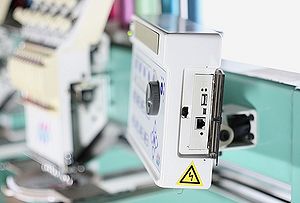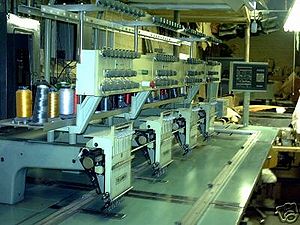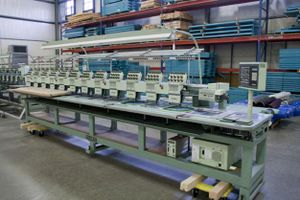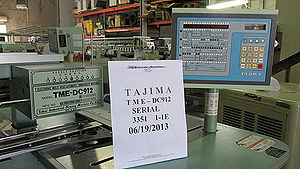Tajima
{{#invoke:Infobox|infobox}}
Tajima is a manufacturer of single and multi-head embroidery machines. The Tajima embroidery machine company is based out of Japan. Tajima is one of the most well-known brands in embroidery machine manufacturing. Tokai Industrial Sewing Machines Co. LTD was the original manufactures of the machines distributed by Tajima.
Tajima Embroidery Machines (China) Co., Ltd. was established in 2001 in Jieyang, Guangdong, China, to manufacture machines in China.
Tajima has produced embroidery machines with 1, 2, 4, 6, 8, 10, 12, 15, 20 and 24 heads. In The United States most Tajima models are 1, 2, 4, 6 and 12 head. Most the 8 head machines and machines larger than 12 heads were more common in other countries. Very few 8 heads can be found in the United States but are much more common in Asian countries. Tajima has produced machines with 1, 3, 4, 6, 9, 12 and 15 needles. Machines with 6 needles are common in the very early 1990s. 9 needle machines became popular during the mid 1990s. Late 1990s to around 2010 most machines were 12 needles. 15 needle machines are standard now. Tajima machines with less than 6 needles are generally specialty machines.
History, origin and sales
The Tajima embroidery machine company rose to popularity in the United States between the very late 1980s and the very early 1990s. The early model Tajimas produced till around 1996 had a greenish color scheme. Around 1996, Tajima machines changed from the light green color scheme (with dark green logo) to their more common white color scheme with a green, pink and blue logo. Tajima, along with Barudan of Japan, became a top two embroidery machine maker in the USA. Both Barudan and Tajima continue to be the two leading makers of embroidery machines for the United States market.
Tajima continues to lead sales in most of the west and south of the USA whereas Barudan leads sales in the north and east. Most of the rest of the United States is evenly divided among the two major embroidery machines (Tajima and Barudan). Tajimas are more commonly seen around Mexico and most of Central America whereas Barudan tends to lead sales in countries such as Colombia, Peru, Venezuela. Countries such as Argentina, Canada, Brazil, and Chile are divided among both Tajima and Barudan for popularity rights.
Tajimas machines original ran off paper punch cards from the 1970s till the 1980s when they were replaced by paper tape. Paper tape was soon replaced by floppy drives. Most all Tajima machines today are now run off USB drives.
Other Equipment
In addition to Tajima producing single and multi-head embroidery machines, Tajima also produces chenille machines, and machines with sequin devices.
Software Extensions
Tajima DST (.dst) is the most common software extension for Tajima software and machines. However, Tajima uses several other embroidery software formats. Tajima DST is the most common embroidery format found.
Embroidery Machines
TME-HC Series
{{#invoke:Infobox|infobox}}
In 1990 Tajima released the TME-HC series embroidery machine. The TME-HC did not come with a floppy disk drive and only came with ports for external readers such as an external paper tape reader or Floppy Drive. The machine came in options of 4,6, 12, 15 or 20 heads. The machine only had manually removable table tops (nothing automatic). The machine was only available as 6 or 9 needles.
1990-1992
In 1990 Tajima released their first TME-HC model. The original HC models had mechanical thread break detectors that ran off a mechanical cam system. When the machine made a color change, the lob of the cam would physically close the thread break detection circuit. The HC models from this era had pretension knobs apart from the heads located in front of the mechanical thread break detection system.
1993-1994
The TME-HC machines released after 1992 came with standard DU-10 power boxes for the X and Y card. Each head was equipped with individual thread break boards and sensors, replacing the original HC design. The machines from this era looked much more like their predecessor, the TME-DC. The last TME-HC machine was produced in 1994.
TME-HC Specifications
| Model | Heads | Needles | EMB Space / Head | Max SPM | Pwr Cons. | Years | Color |
|---|---|---|---|---|---|---|---|
| TME-HC606 (G1) | 6 | 6 | emb Space | SPM | POWEW | 1990-1992 | Green |
| TME-HC612 (G1) | 12 | 6 | emb Space | SPM | POWEW | 1990-1992 | Green |
| TME-HC904 (G1) | 4 | 9 | emb Space | SPM | POWEW | 1990-1992 | Green |
| TME-HC906 (G1) | 6 | 9 | emb Space | SPM | POWEW | 1990-1992 | Green |
| TME-HC912 (G1) | 12 | 9 | emb Space | SPM | POWEW | 1990-1992 | Green |
| TME-HC906 (G2) | 6 | 9 | emb Space | SPM | POWEW | 1993-1994 | Green |
| TME-HC912 (G2) | 12 | 9 | emb Space | SPM | POWEW | 1993-1994 | Green |
TMEX-C / TMFX Series
{{#invoke:Infobox|infobox}}

The Tajima TMFX model has been one of the longest produced models of the Tajima embroidery machine series.
For the Tajima TMFX user manual see Tajima TMFX User Manual
Tajima claims the TMEX-C machine was The World First with Wide Cap Frame. "The WORLD FIRST! The wide cap frame drastically expands your embroidery repertoire to include everything from designs on the front of the cap to designs that extends to the wide panels. It opens up unlimited possibilities for creative cap embroidery and for significant imporments in added value."
A very small percentage (less than 5%) of the TMFX and TMEX machines used narrow height floppy disk drives. The narrow height floppy disk drives have long been discontinued. Only regular sized floppy drives and floppy to USB drives can be used to replace the old 3 1/2 floppy drives on these machines. This means a very few amount of the TMFX control panels must be slight enlarged at the floppy drive port when accommodating these newer style drives.
The Tajima TMFX and TMEX share very similar, almost identical, control panels.
1990-20xx
In 1990 Tajima released the TMFX series embroidery machine. The TMFX models came in both single head and multi-head versions. The first TMFX model was the TMFX-C901 model which was a nine needle single head embroidery machine. The machine had automatic color change and automatic trimmers. The single head and dual head models both had removable bases.
1995
In 1995 Tajima released the TMEX-C embroidery machine. The TMEX-C was designed to replace the single head TMFX model.
Tajima only used the TMFX model as a single head for a very short period. The single head was then commonly known as the TMEX-C machine which was basically a one head version of the TMFX.
TMEX-C / TMFX Specifications
| Model | Heads | Needles | EMB Space / Head | Max SPM | Pwr Cons. | Years | Color |
|---|---|---|---|---|---|---|---|
| TMEX-C901 | 1 | 9 | 280 x 500mm | 1200 | 400W | 1995-1996 | Green |
| TMEX-C1201 | 1 | 12 | 280 x 500mm | 1200 | 1996-1999 | White | |
| TMEX-C1501 | 1 | 15 | 280 x 500mm | 1200 | 1999-2007 | White | |
| TMFX-C901 | 1 | 9 | 1990-1992 | Green | |||
| TMFX-C902 | 2 | 9 | 1990-1994 | Green | |||
| TMFX-C904 | 4 | 9 | 1990-1992 | Green | |||
| TMFX-C906 | 6 | 9 | 1990-1994 | Green | |||
| TMFX-C902 | 2 | 9 | 1995-1997 | White | |||
| TMFX-C904 | 4 | 9 | 1995-1997 | White | |||
| TMFX-C906 | 6 | 9 | 1995-1997 | White | |||
| TMFXC-1202 | 2 | 12 | 1996-2001 | White | |||
| TMFXC-1204 | 4 | 12 | 1996-2001 | White | |||
| TMFXC-1206 | 6 | 12 | 1996-2001 | White | |||
| TMFXC-1502 | 2 | 15 | 2002-2010 | White | |||
| TMFXC-1504 | 4 | 15 | 2002-2010 | White | |||
| TMFXC-1506 | 6 | 15 | 2002-2010 | White |
TME-DC Series
{{#invoke:Infobox|infobox}}
For the Tajima TME-DC user manual see Tajima TME-DC User Manual
In 1994 Tajima released the TME-DC series embroidery machine.
The Tajima TME-DC was the next model up from the TME-HC model produced the previous years before. Unlike the TME-HC machine, the Tajima TME-DC models came standard with a Floppy Disk Drive. The Tajima DC series also came with upgraded control panel, motors, and motor controllers. Many models of the Tajima DC also came with Hydraulic Tables but, standard removable table tops were still available on some for a lesser price. The Tajima TME-DC models were available in 6, 12, 15 and 20 heads. The early machines built in the early and mid 1990s were mostly 9 needles. Around year 2000 most all models were standard 12 needles.
The TME-DC machine was the first Tajima multihead machine with a floppy drive. The machine can also be upgraded to FloppyToUSB
1994-1996
The first models of the Tajima TME-DC series were green machines. The only green machines were produced 1994 - 1996. Some of the 1996 models might be white color. The machine either had removable tables or hydraulic tables.
The machine was very similar to the earlier TME-HC model but, had upgraded electronics including the control panel, IMM, IDM, motor, motor controller, etc. The machine also had a floppy drive which can be upgraded to Floppy To USB
1997-1999
TME-DC Specifications
| Model | Heads | Needles | EMB Space / Head | Max SPM | Pwr Cons. | Years | Color |
|---|---|---|---|---|---|---|---|
| TME-DC906 (G1) | 6 | 9 | emb Space | SPM | POWEW | 1994-1996 | Green |
| TME-DC912 (G1) | 12 | 9 | emb Space | SPM | POWEW | 1994-1996 | Green |
TMFD Series
{{#invoke:Infobox|infobox}}
For the Tajima TME-DC user manual see Tajima TME-DC User Manual
The Tajima TME-DC was the next model up from the TME-HC model produced the previous years before. Unlike the TME-HC machine, the Tajima TME-DC models came standard with a Floppy Disk Drive. The Tajima DC series also came with upgraded control panel, motors, and motor controllers. Many models of the Tajima DC also came with Hydraulic Tables but, standard removable table tops were still available on some for a lesser price. The Tajima TME-DC models were available in 6, 12, 15 and 20 heads. The early machines built in the early and mid 1990s were mostly 9 needles. Around year 2000 most all models were standard 12 needles.
1994-20xx
TMFD Specifications
| Model | Heads | Needles | EMB Space / Head | Max SPM | Pwr Cons. | Years | Color |
|---|---|---|---|---|---|---|---|
| TME-DC906 (G1) | 6 | 9 | emb Space | SPM | POWEW | 1994-1996 | Green |
| TME-DC912 (G1) | 12 | 9 | emb Space | SPM | POWEW | 1994-1996 | Green |
NEO
{{#invoke:Infobox|infobox}} The Tajima Neo is the only table-top, compact machine ever made by Tajima. The Neo is an entry-level machine in the Tajima lineup of embroidery machines. The first Tajima Neo was manufactured in 2002. In Tajima marketing materials, NEO stood for "Never Ending Opportunities" which was meant to emphasize the machine's ability to work with a wide variety of garments.
(TEJTII-C) Series
The first Neo was the 2002 Tajima Neo II TEJT C1501. It was a single-head machine with a sewing field of 19.4 x 14inches, and was a scaled-down version of a standard commercial embroidery machine. The Neo II was portable and came with a stand (with wheels) which made it convenient for taking to sporting events, craft fairs, kiosks and trade shows. The Tajima Neo II series had 15-needle, 12-needle, and 9-needle versions. The Neo came with a floppy disk drive.
The 2004 Tajima Neo TEJT-C1501 featured 270 degree cap sash, tubular sash, one set of 270 cap frames, five sets of tubular hoops, removable table,
NEO Specifications
| Model | Heads | Needles | EMB Space / Head | Max SPM | Pwr Cons. | Years |
|---|---|---|---|---|---|---|
| TEJTII-C | 1 | 15 | 19.4 IN x 14 IN | SPM | POWEW | 2002 - Present |
(TEHX-C) Series
{{#invoke:Infobox|infobox}}
The TEHX-C1501 Tajima was a single-head machine featuring 15 needles.
TEHX-C Specifications
| Model | Heads | Needles | EMB Space / Head | Max SPM | Pwr Cons. | Years |
|---|---|---|---|---|---|---|
| TEHX-C | 1 | 15 | 19.4 IN x 14 IN | SPM | POWEW | 2002 - Present |
Tajima Legend
Tajima used several codes in their models that described basic features of the machines.
- TMEF
- Machines with the F code are Bridge Machine (not arm type)
Head Gallery
Below are a few examples of the heads used for the Tajima machines over the years:
Buying
Tajima embroidery machines are probably one of the best machines on the market. They are more expensive that most all competing models but, they are very solidly built and have a good resell market. There are a lot of embroidery machine technicians available world wide and parts are pretty easy to find even for older models.
Selling
TheEmbroideryWarehouse buys and sells most every make and model of Tajima embroidery machines located within the continental USA. They also purchase parts, parts machines, salvage machines and most everything else related to embroidery equipment.
Repairs
See also
References
| references-column-width
| references-column-count references-column-count-{{#if:1|2}} }}
| {{#if:
| references-column-width }} }}" style="{{#if: 2
| {{#iferror: {{#ifexpr: 2 > 1 }}
| -moz-column-width: {{#if:1|2}}; -webkit-column-width: {{#if:1|2}}; column-width: {{#if:1|2}};
| -moz-column-count: {{#if:1|2}}; -webkit-column-count: {{#if:1|2}}; column-count: {{#if:1|2}}; }}
| {{#if:
| -moz-column-width: {{{colwidth}}}; -webkit-column-width: {{{colwidth}}}; column-width: {{{colwidth}}}; }} }} list-style-type: {{#switch:
| upper-alpha
| upper-roman
| lower-alpha
| lower-greek
| lower-roman = {{{group}}}
| #default = decimal}};">
<references group=""></references>


